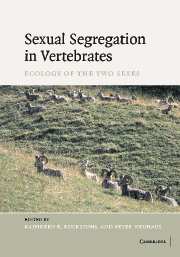Book contents
- Frontmatter
- Contents
- List of contributors
- Preface
- Part I Overview
- Part II Concepts and methodology
- Part III Foraging ecology
- Part IV Predator avoidance and reproductive strategies
- Part V Sex-related activities and social factors
- Part VI Sexual differences in ecology: comparisons within different taxa
- 13 Ecological divergence between the sexes in reptiles
- 14 Sexual segregation in Australian marsupials
- 15 Social systems and ecology of bats
- 16 Sociality and ecology of the odontocetes
- 17 Sexual segregation in non-human primates
- Part VII Implications for conservation
- Part VIII Outlook
- References
- Index
13 - Ecological divergence between the sexes in reptiles
Published online by Cambridge University Press: 04 September 2009
- Frontmatter
- Contents
- List of contributors
- Preface
- Part I Overview
- Part II Concepts and methodology
- Part III Foraging ecology
- Part IV Predator avoidance and reproductive strategies
- Part V Sex-related activities and social factors
- Part VI Sexual differences in ecology: comparisons within different taxa
- 13 Ecological divergence between the sexes in reptiles
- 14 Sexual segregation in Australian marsupials
- 15 Social systems and ecology of bats
- 16 Sociality and ecology of the odontocetes
- 17 Sexual segregation in non-human primates
- Part VII Implications for conservation
- Part VIII Outlook
- References
- Index
Summary
OVERVIEW
Living reptiles display an immense diversity in morphological, physiological, behavioural and ecological traits. Indeed, ‘reptiles’ actually constitute a highly polyphyletic assemblage, encompassing four major lineages that diverged >200 million years ago. The extant taxa comprise 7390 species of squamates (lizards and snakes), 295 of turtles, 23 of crocodilians and 2 species of sphenodontians (the New Zealand tuatara) (Uetz, 2000). Correspondingly, the ways in which ecological divergence is manifested between the sexes, and the selective pressures and proximate mechanisms responsible for such divergence, take many forms. This chapter will outline the kinds of ecological traits known to differ between males and females in reptiles, and then explore the degree to which such differences are consistent with alternative hypotheses. Historically, conceptual models to predict and explain segregation between the sexes have been developed by workers with a primary focus on endothermic vertebrates, especially ungulates (see Chapters 2, 3, 9, 10, 11 and 19). Inevitably, the kinds of arguments that have been developed rely upon specific features of these organisms, so that attempts to interpret analogous sexual segregation phenomena in reptiles cannot be neatly subsumed within the same framework. However, the analogies in many cases are clear enough, and the framing of the models broad enough, that strong parallels can be drawn. Thus, we use the conceptual framework developed by ungulate biologists to categorize and investigate causal mechanisms for segregation between the sexes within reptile populations. We then propose a framework with which to analyse studies of sexual segregation.
- Type
- Chapter
- Information
- Sexual Segregation in Vertebrates , pp. 221 - 253Publisher: Cambridge University PressPrint publication year: 2006
- 4
- Cited by



